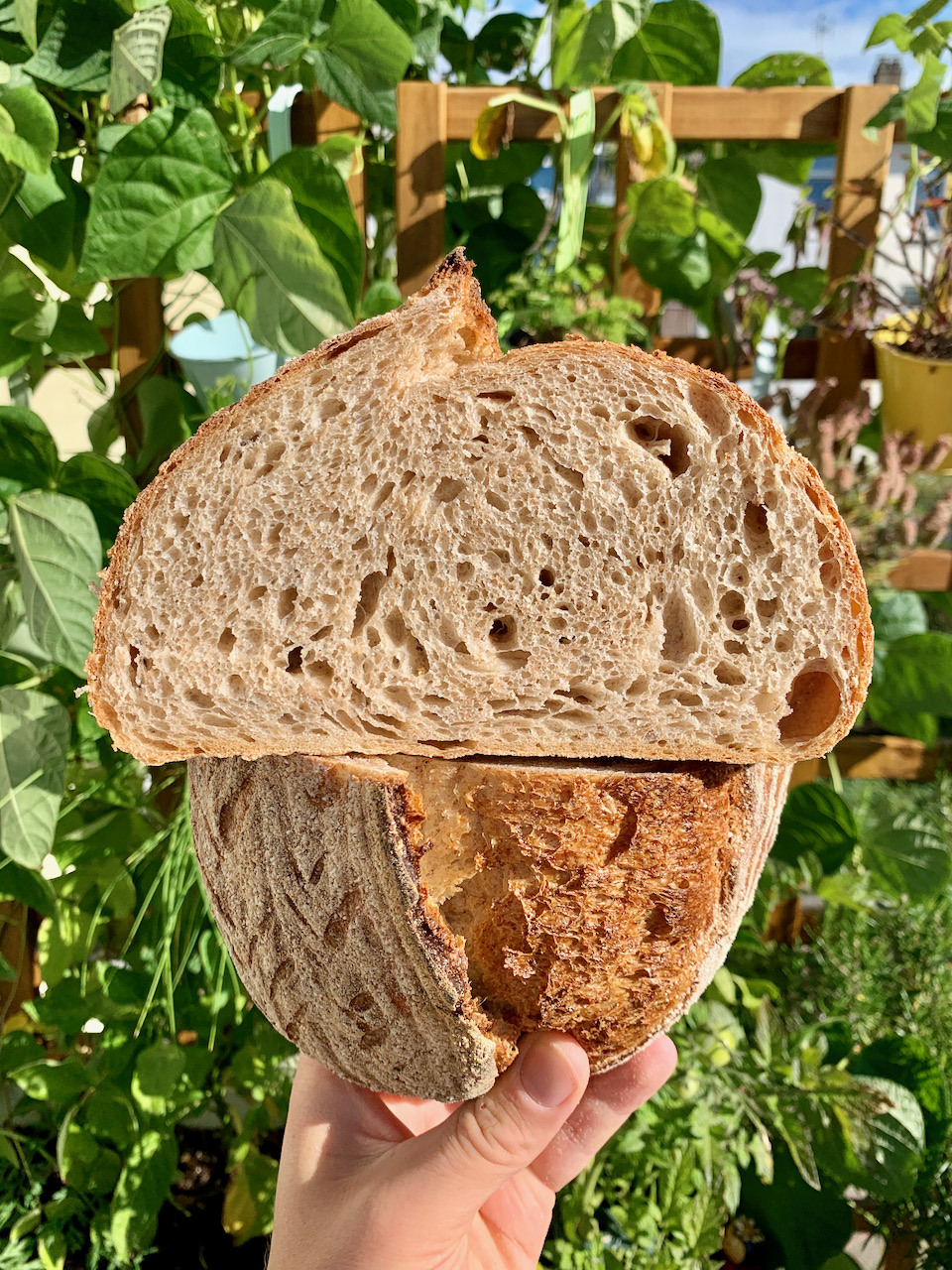 The Bread Code Sourdough
The Bread Code Sourdough

 Serves Serves |  Total Time Total Time |
|---|---|
| 1 loaf | 14.85 hours |
The Sourdough Calculator may be used to generate a recipe.
 Ingredients
Ingredients
400 g (80%) bread flour
100 g (20%) whole wheat flour
325 g (65%) water
100 g (20%) starter
10 g (2%) salt
 Cookware
Cookware
- 1 bowl
- 1 cylindrical shaped container
- 1 Dutch oven
- 1 cooling rack
 Instructions
Instructions
Autolyse
Step 1
At night, mix bread flour, whole wheat flour, and water in a bowl, fully hydrating the flour. Let it rest, covered, at room temperature over night for 12 hours. Make sure that there are no crumbly parts of flour left.
Bulk Fermentation
Step 2
The next morning, add the active starter to the main dough. Add the salt to the main dough. Mix until everything is nicely homogenized (very important). For me this takes around 1 minute. It might take you up to 5 minutes. You want to make sure the sourdough starter has been evenly spread across the dough.
Step 3
Let the dough sit for another 15 minutes covered and check for the window pane effect
Step 4
Now remove the dough and place it on your bench (no flour!) and knead.
Step 5
Extract a small sample from the dough and place it in a cylindrical shaped container. A shot glass works, or anything else that has a cylindrical shape. This sample will tell us exactly when the dough is done bulk fermenting. Mark the dough with a rubber band or a marker. This way we can see the size increase.
Step 6
Let the dough sit for another 15 minutes covered.
Step 7
Proceed with kneading the dough on the bench. It’s important that you have no flour on the surface. Pull the dough as far out as you can, without tearing it. Fold over the dough to glue itself together.
Step 8
Repeat once from each side.
Step 9
Drag the dough over the surface using your hands at a 45° angle. This only works because the dough is stuck on the surface. Your dough ball should become nice and round.
Step 10
Wait a minute, repeat the same process 3 times.
Step 11
Add dough to container and wait 2 hours or until the dough has doubled in size.
Step 12
Slightly wet hands with cold water. Release dough from sides of container.
Step 13
Using a very light touch, do a coil fold. Do 2 opposite sides, then 3rd side pull dough under and then 4th side roll it over.
Step 14
Return to container and cover and wait until the dough doubles in size. This can take anywhere between 4 and 12 hours. Every 2 hours, do the coil fold.
Shaping the Dough
Step 15
Prepare your banneton (if using) and very lightly flour counter/surface.
Step 16
Flip dough out onto it. Do letter fold and stick dough together. Pinch ends closed (for oval loaf). Pinch bottom seam together, for more tension (for boule).
Step 17
Lightly sprinkle flour over top (and rice flour along sides of banneton, to prevent sticking).
Proofing Stage
Step 18
Will take 2 to 4 hours at room temperature (until the finger poke test is passed). Place shortly before the finger poke test passes in the freezer for 45 minutes to make scoring easier.
Step 19
Or - place for 1 hour at room temperature, then another 6 to 24 hours in the fridge. This way your bread will be ready directly for breakfast.
Baking
Step 20
Preheat oven at 450°F for maximum for at least 30 minutes.
Step 21
If using Dutch oven, heat it in the oven for about 30 minutes (lid separated). If baking on sheet or stone, heat stone and sheet while heating oven. Also heat the container (e.g. cast iron skillet) at the bottom of the oven to use to create steam).
Step 22
Place inverted baking tray (with sides) on uppermost rack of oven after putting in bread, to catch the steam. At 30 minutes, remove this tray and the water container.
Step 23
Gently turn dough out of banneton onto parchment, or directly into hot dutch oven (careful!).
Step 24
Score dough to control where you will have oven spring. This takes a few attempts. You can practice this when you initially kneaded and made a smooth ball.
Step 25
Place in Dutch oven or on baking stone or sheet.
Step 26
Bake for 30 minutes covered. Remove lid of Dutch oven or remove top inverted tray and water container (if using). This makes sure we no longer have steam. That way you will develop a nice crust.
Step 27
Bake for 15 to 20 minutes more until your bread has your personal desired color. It is ready when the core temperature reached 203°F.
Resting Stage
Step 28
Let the bread cool on a cooling rack for at least 2 hours.
 Source
Source